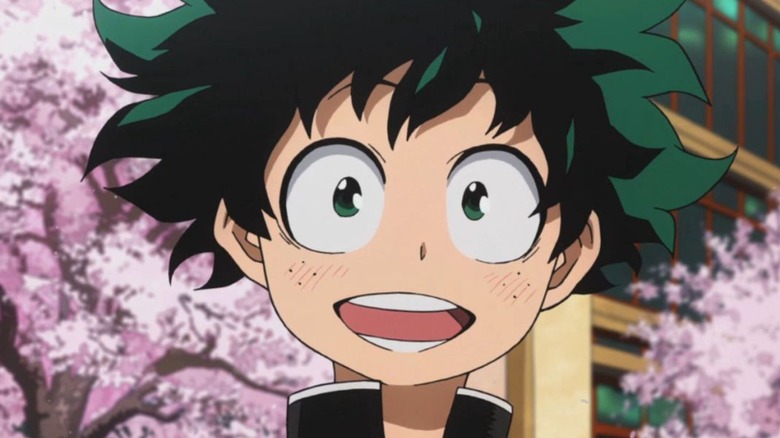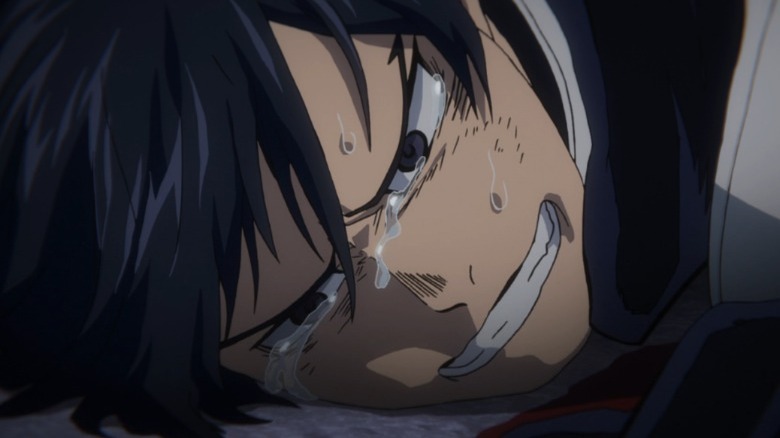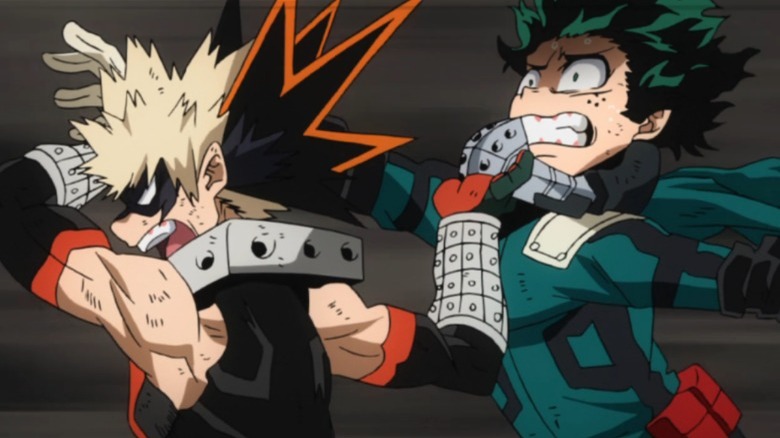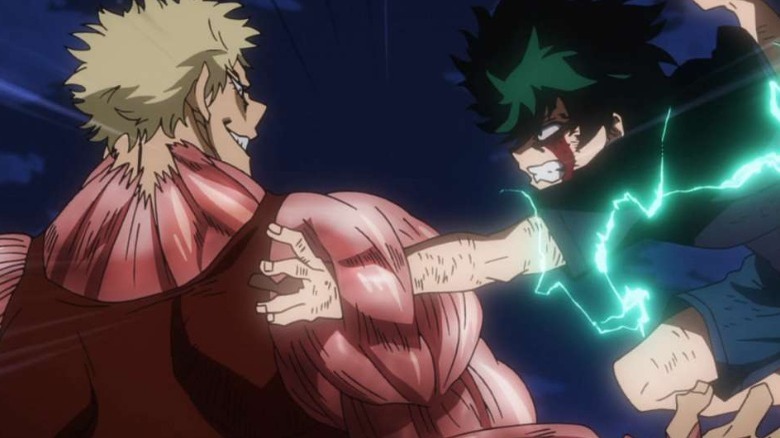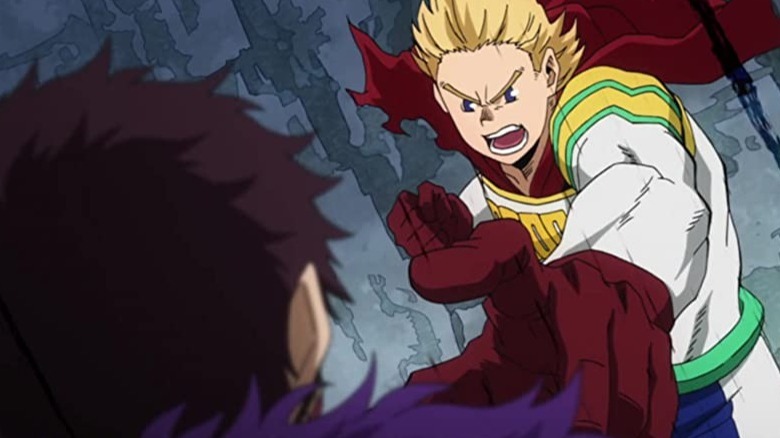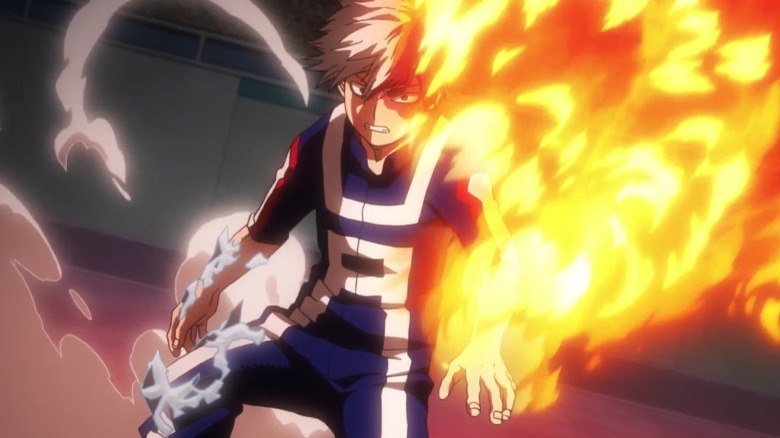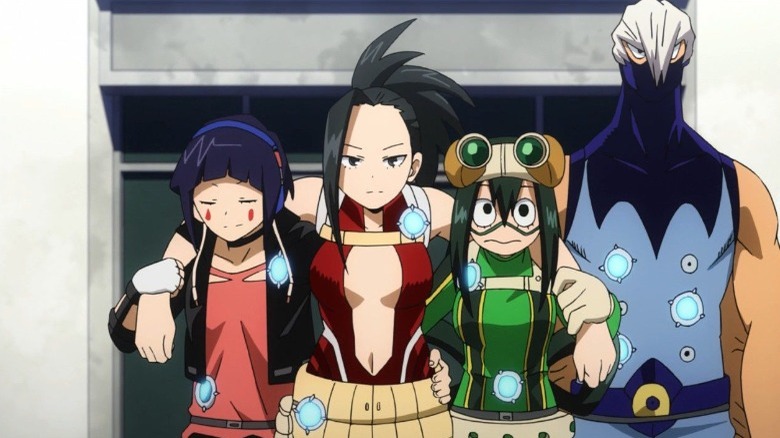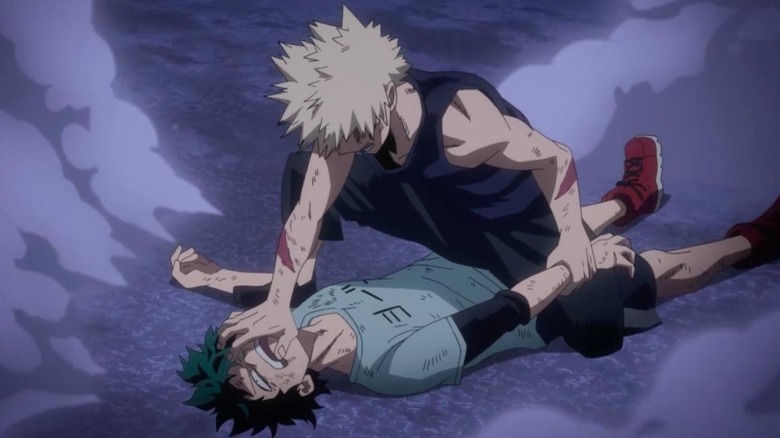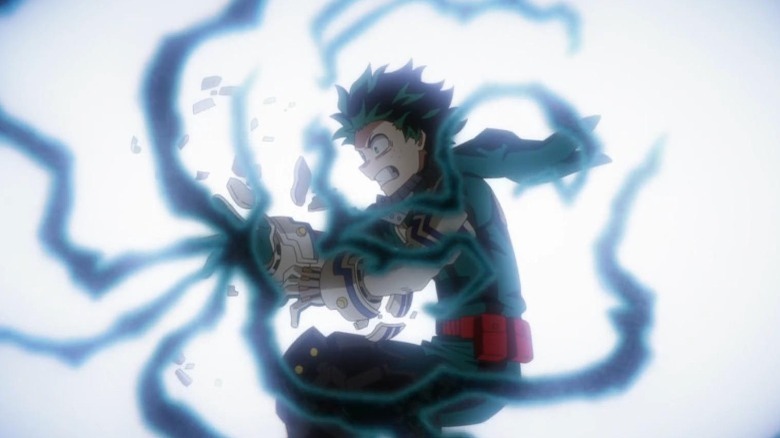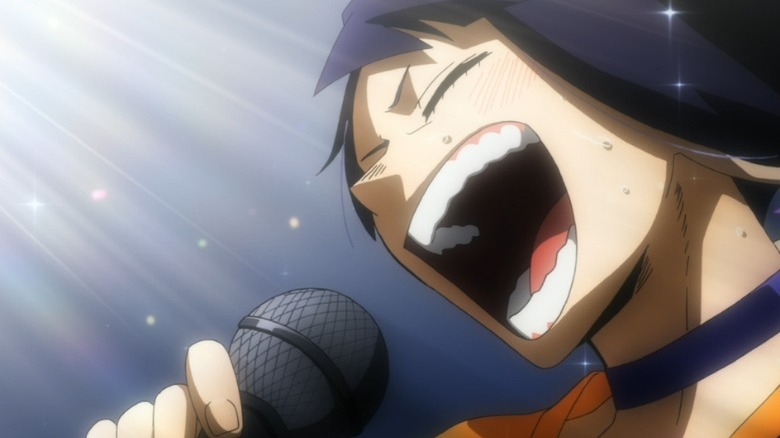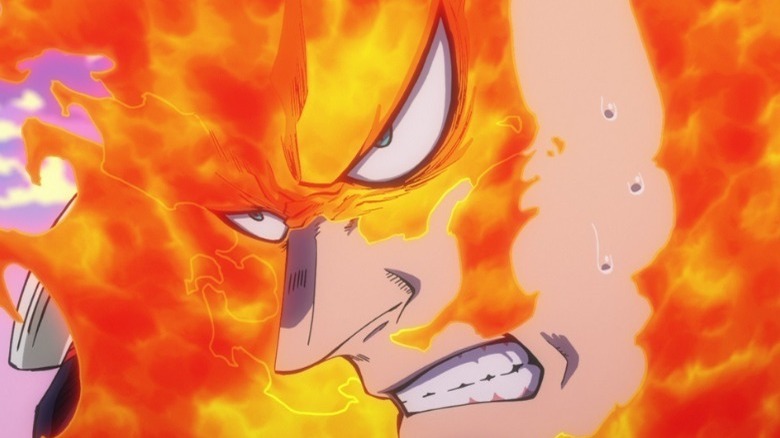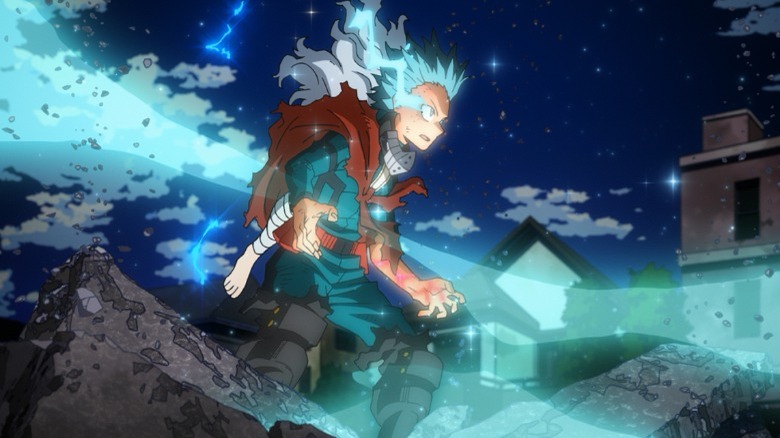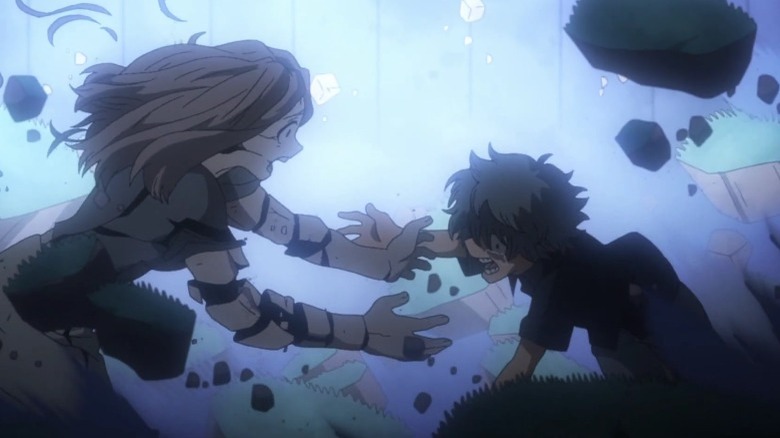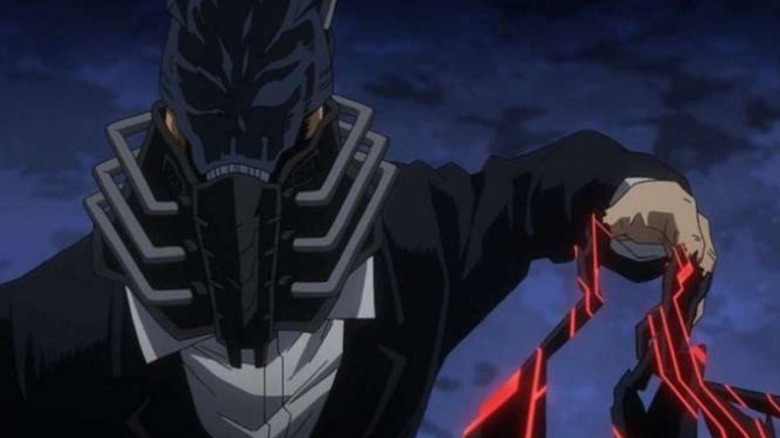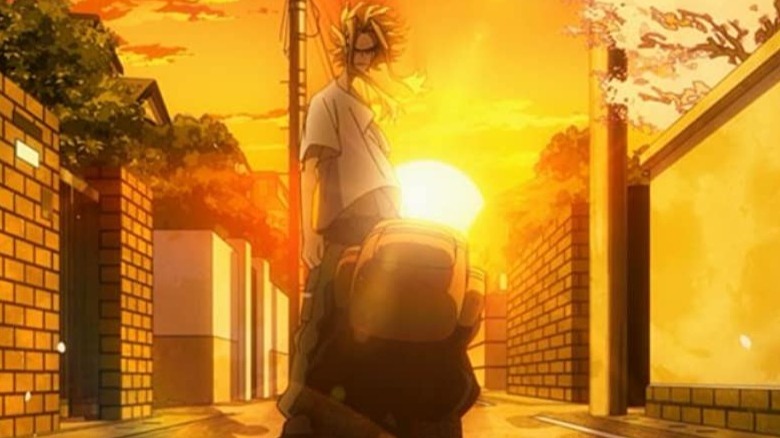The 14 Best My Hero Academia Episodes Ranked
"My Hero Academia" is one of the most popular anime series currently airing. Fans can't get enough of its subversion of superhero tropes, or the way it gives the Marvel Cinematic Universe a run for its money when it comes to assembling a team of diverse, disparate heroes.
While it's principally the story of Izuku Midoriya and his newfound "quirk," which is what the show calls superpowers, the scope of "My Hero Academia" has expanded to encompass the entirety of Midoriya's class at UA High School as well as a number of the heroes around them. Notable for its goodwill and proud, beating heart, "My Hero Academia" drives home the message that heroism involves more than raw strength. It requires heart, spirit, and character.
Thankfully, the series has plenty of all three. Tense, funny, tender, and even occasionally frightening, "My Hero Academia" weaves a tapestry of pitch-perfect arcs, coming-of-age journeys, and monstrous, terrifying villains. Though it's a hard list to whittle down, these are the 14 best episodes of "My Hero Academia" thus far.
14. Climax (Season 2, Episode 17)
It's highly conspicuous when Class 1-A hero Tenya Ida leverages his internship for placement in Hosu City. Looking to track down the Hero Killer, Stain, and get vengeance for the attack on his brother, Ida finds what he was looking for just as the League of Villains and several Nomu, monsters created from human corpses, descend on the city. "My Hero Academia" is excellent at grounding the students' respective quirks, showing clear progress and control from season to season and honoring combatants' respective grasp on their powers and experience levels. In other words, Ida is no match for Stain.
Fortunately, Deku and Todoroki arrive, and together the three heroes defeat Stain and save Ida from imminent death. It's a powerhouse moment replete with quick strategizing, close calls, and all the galvanizing moments of friendship that anime fans could hope for. Additionally, with Stain out of commission, the series begins its dark descent into a world bewitched by the Hero Killer's philosophy, which will continue to shape the world of "My Hero" well into its forthcoming sixth season.
13. Katsuki Bakugo: Origin (Season 2, Episode 24)
The practical component of Class 1-A's final exams involve pairing up the students and making them compete against UA High School's faculty. In these contests, students either need to escape the arena through an arched exit or capture their teacher (and their rival) before time runs out. Naturally, Deku and Bakugo are paired together against All Might, and early on things go exactly as viewers might expect. Deku is convinced that escaping is the best option, as he recognizes that neither student is capable of matching All Might's strength, while Bakugo is determined to fight.
Although he's a fan favorite, "My Hero Academia" has struggled with Bakugo. His growth is largely limited to increases in his power, with only marginal improvements to his character. He's a bit better at teamwork than he used to be, and that's treated like enough to sustain an entire season's worth of development.
Luckily, "Katsuki Bakugo: Origin" is a better showcase for Deku, demonstrating his unrivaled optimism and ongoing commitment to a hero's ideals. Against all odds, Deku follows Bakugo's lead, and the two scrape by with a win. Additionally, this episode gives Bakugo a much needed beatdown, demonstrating how far he still has to go.
12. My Hero (Season 3, Episode 4)
Season 3 of "My Hero Academia" starts with the students of both Class 1-A and 1-B being shuttled to a woodland camp for a summer of intense training under the supervision of the Pussycats, a group of professional heroes. Naturally, Deku is immediately drawn to Kota, an orphan whose parents were killed, imbuing him with a fervent hatred for all things hero. By this point, viewers know that if anyone is going to change his mind, it's Deku.
The League of Villains attacks, and soon Muscular has trapped Kota in his secret hideout. Deku swoops in, although his burgeoning control over One for All isn't enough to withstand Muscular's superhuman strength and fortitude. In a last-ditch effort to save Kota, Deku harnesses the power of One for All at 1,000,000% (seriously) and Detroit Smashes Muscular into oblivion.
"My Hero" is a standout episode not only in its development of the ongoing League of Villains arc, but also in Deku's use and control of his quirk. With his arm all but destroyed by his power, Deku adopts a different fighting style, one that he maintains for the rest of the show. It's an episode that's indicative of both Deku's adaptability and his heart, easily proving why All Might chose him as his successor.
11. Lemillion (Season 4, Episode 11)
The Shie Hassaikai arc of the 4th season of "My Hero Academia" is incredibly stressful. These days, most audiences are well-equipped to pick up on impending character deaths, and this storyline all but explicitly taunts fans with the inevitable demise of one of their favorite heroes-in-training. Luckily, third-year student Lemillion's increased role and commitment to saving Eri from the clutches of leader Overhaul luckily doesn't end in his passing (that unfortunate honor belongs to All Might's sidekick, Sir Nighteye), but it does come pretty close.
In his fight against Overhaul, Lemillion makes excellent use of his quirk, which allows him to pass through objects with ease. However, his power is no match for Overhaul's quirk enhancers, and Lemillion is all but dead by the time that Deku and company arrive deus ex machina-style to save the day. Noteworthy for subverting tropes and a pretty cool battle, "Lemillion" adroitly captures how rich and textured the world of "My Hero Academia" is. Lemillion, forever the optimist, shows considerable bravery and vulnerability in his fight against Overhaul, even if he ends up losing his quirk at the end, ostensibly for good.
10. Todoroki Origin (Season 2, Episode 10)
Former second-place hero Endeavor is one of the biggest successes and most misguided failures on "My Hero Academia." His son, Class 1-A prodigy Shoto Todoroki, inherited a combination of both his mother's and father's quirks, and can harness both fire and ice in combat. However, he resists using his flame powers; in "Todoroki Origin," the audience learns why.
Growing up, Endeavor trained Todoroki ruthlessly, to the point where he neglected everyone else. In fact, Endeavor effectively terrorized his loved ones, almost irreversibly fracturing his family. As a result of the severe physical and emotional abuse she suffered, Todoroki's mother poured burning water on his face and was subsequently institutionalized.
It's dark stuff, and not the type of subject matter that "My Hero Academia" is always equipped to handle. The series often ignores that Endeavor isn't just a bad husband and father— he's a serial abuser. Still, Todoroki's fight with Deku during the UA Sports Festival is the first time that the boy uses his fire powers, and Deku teaches him that both sides of his quirk are okay to use. Deku loses the match as a result, and Todoroki learns how to make full use of his power without conceding to his father's cruel whims.
9. Class 1-A (Season 3, Episode 17)
To the chagrin of some fans, "My Hero Academia" sometimes strays from the seasons' principal arcs to focus on Class 1-A's peripheral players. Admittedly, the likes of Shoji, Yaoyorozu, and Jiro don't possess quirks that are flashy enough to sustain the series on its own, but these detours offer welcome reprieves from the show's tendency to reduce conflicts to showcases of raw power.
In the middle of the Provisional Licensing Exam arc, the members of Class 1-A are feeling the pressure. With Stain's capture, the reveal of All Might's secret, and a swelling criminal underground, the world needs heroes more than ever, even if they're still high school freshmen. Soon, Shoji, Sue, Jiro and Yaoyorozu are trapped in a building as a competing class closes in, and all hope seems lost.
However, in an adrenaline-fueled rush of strategy, teamwork, and quick thinking, the Class 1-A quartet emerges victorious, passing the exam's first round. In the absence of any kind of physical prowess, it's thrilling to watch the students put their training to the test. It's also a galvanizing moment for Yaoyorozu and her creation quirk, especially given her hesitancy in the 1st season. In other words, "My Hero Academia" is about more than Deku, Bakugo, and Todoroki, and it's all the better for it.
8. Deku vs. Kachan: Part 2 (Season 3, Episode 23)
Season 3's "Deku vs. Kachan: Part 2" suffers from some of the same Bakugo-related problems the show has had since its inception and the revelations found here don't have a profound impact on the show's trajectory. However, as a showcase for the human hiding behind Bakugo's ego, it's a masterpiece. Now living in the dorms, Bakugo drags Deku to a training ground to fight. The battle gives Deku the incentive to harness 8% of One For All, and Bakugo considerably improves his combat prowess, too.
The episode's emotional punch, however, comes from the gut-wrenching revelation that Bakugo feels responsible for All Might's retirement. If he'd just been stronger, Bakugo reasons, the Camino incident would never have happened. All Might arrives right when Bakugo wins the fight, reminding both boys that the thing they lack abounds in the other. Bakugo needs Deku's heart, and Deku needs Bakugo's commitment to winning. It's the closest that Bakugo ever comes to feeling like a fully-developed character, and that alone makes this episode worth watching.
7. That Which Is Inherited (Season 5, Episode 10)
"That Which Is Inherited" has a pretty cool twist with the potential to radically reshape Deku's use of One For All. After several odd dreams in which the vestiges of a quirk try to communicate with Deku, the boy witnesses its power first hand when Classes 1-A and 1-B face off in combat matches. Black tendrils emerge from Deku's body during the fight, endangering everyone in the match. It's Uraraka and Shinso who calm Deku down and allow him to regain control.
Yet, the power itself isn't dormant, and the tendrils actually come from a previous All For One user's quirk. In other words, Deku has the unique capacity to not just take on All Might's strength, but the quirks of all previous One For All wielders, profoundly increasing his power. With so many quirks manifesting and the tendril power, known as Blackwhip, coming under Deku's control as the season concludes, our hero suddenly has many more tools at his disposal.
6. Let It Flow (Season 4, Episode 23)
"My Hero Academia" fans aren't always happy when the show subverts shonen anime tropes, eschewing the combat and tension for a welcome reprieve from physical conflicts. Some of the show's best moments are found in these digressions, however, and these tender, seemingly inconsequential beats aptly demonstrate why "My Hero" has as many fans as it does.
In "Let It Flow," the school festival is underway. Deku's brief fight with Gentle Criminal reaches a welcome conclusion; had the fight dragged on, it might have felt like overkill. But it doesn't, and Deku returns in time for Class 1-A's festival showcase: a concert performed by the entire class. Bakugo is on drums, Deku dances, and Jiro gets her moment to shine as she performs an original number for the entire school. Special guest Eri even smiles for the first time, thrilling Deku and Lemillion. The entire enterprise is so resoundingly sweet that it's hard to not be won over by its rocking, bopping charm.
5. His Start (Season 4, Episode 25)
That concert better be nice, because just two episodes later, "My Hero Academia" concludes its 4th season on a grim, disquieting note. The focus shifts to Endeavor and his struggle with being the world's top hero, uncertain of how to best apply the wise words All Might offered earlier in the year. At the same time, the audience is introduced in earnest to Hawks, the second-place hero and the League of Villains saboteur.
A high-end Nomu unlike anything seen before attacks the city, and Endeavor must stop it before it wreaks unimaginable havoc. It's a tense, relentless fight, with Endeavor finding his match in the Nomu's unimaginable strength. However, when all hope seems lost, Endeavor wrestles the Nomu high into the sky, using more power than ever before. The note that the incident ends on is far from celebratory, however. Though Endeavor succeeds, the battle foreshadows the horrors yet to come and hints that hero society might not be capable of withstanding them.
4. Infinite 100% (Season 4, Episode 13)
The flaws in "My Hero Academia" are incredibly small, but those that do exist can be remarkably irritating. Deku's growing control over One For All propels the show forward, but the peripheral awareness of those around him is sometimes confounding. Take, for instance, Deku's role in defeating Overhaul. That should be a pretty big deal, but, in the aftermath, it generates little more than passing interest.
Still, the moment when, with help from Eri's rewind quirk, Deku sustains 100% of his power is arguably one of the best in the series. It's gorgeously animated, profoundly tender, and really cool. Deku is able to defeat an overpowered Overhaul and keep damage to a minimum while freeing Eri from his clutches. It further grounds Deku's development as a hero, proving his willingness to fight without knowing the toll the battle will take on him. It doesn't matter if Deku survives the fight — he's going to save Eri either way.
3. Tenko Shimura: Origin (Season 5, Episode 23)
At times, "My Hero Academia" goes a bit too far when celebrating its villains. Depiction doesn't equal an endorsement, of course, but "My Hero Academia" isn't especially shy about driving home just how cool its bad guys are. It's not an especially egregious trend, and it's certainly not the only shonen anime to traffic in villainous love (looking at you, "Hunter x Hunter"), but at times this focus can feel at odds with the show's innate thesis that good triumphs over evil.
The folks behind "My Hero Academia" made an especially bold choice at the tail end of season 5, when the title cards began to read "My Villain Academia." The League of Villains travel to Deika City to meet the leader of the Meta Liberation Army, an ostensibly neutral group whose intent is to free society from the laws governing quirks. Shigaraki fares well against Re-Destro, the group's leader, leveling up his quirk in the process.
However, Shigaraki is besieged by flashbacks of his childhood. We learn that he's the grandson of All Might's predecessor, and the episode details his abuse-filled childhood and the death of his entire family at his hands. It's grim, violent stuff, trading in horror imagery more than the series typically does. Shigaraki's sister, his parents, and even the family dog are brutally killed by a quirk that the young Shigaraki doesn't understand. More than anything, this episode profoundly recontextualizes Shigaraki's goals.
2. One For All (Season 3, Episode 11)
"My Hero Academia" has milked plenty of tension from All Might's reduced abilities. When the series begins, All Might returns to his original form if he uses his powers for too long, a trait that's sometimes played for laughs, and that accounts for plenty of close calls as All Might and Deku endeavor to keep his injuries a secret. As a symbol of peace, the public's perception of All Might is key, and knowing about the top hero's considerable injuries could rattle the people's faith.
As All Might and his nemesis, All For One, continue their clash in Camino ward, All For One reveals his role in nurturing Tomura Shigaraki, the grandson of All Might's mentor. All Might's righteous fury at this news incites his strongest, and final, attack, the United States of Smash. All For One is defeated and taken into custody, but not before the entire world sees All Might emaciated and broken. He delivers one final message before retiring from heroism for good. While most people regard the speech as a threat against villains, we know that it's actually a tender message to Deku — it's Midoriya's time to become the new symbol of world peace.
1. What It Takes to Be a Hero (Season 1, Episode 2)
The second episode of "My Hero Academia" contains what is, arguably, one of anime's most triumphant moments. In "Izuku Midoriya: Origin," our protagonist, who also goes by the hero name "Deku," is introduced in all his wannabe, quirkless glory. As people with quirks have swelled in numbers, Deku is devastated to learn he does not possess one, putting an apparent end to his dream of becoming a hero. And yet, with the entrance exam for UA High School on the horizon, Deku remains hopeful, much to the chagrin of Bakugo, a sociopathic bully whose sole purpose in life appears to be tormenting Deku.
In "What it Takes to Be a Hero," All Might is in town and tells Midoriya that, without a quirk, Deku has no hope of becoming a hero. However, around the same time, Bakugo is captured by a villain. Without thinking, Deku rushes in to save him. Though Deku is unsuccessful, All Might takes note, and later reveals his true form to the boy. On account of an old injury, All Might can only maintain his hero form for a few hours; the rest of the time, he's an emaciated weakling. All Might then commends Deku's bravery, saying that his behavior epitomizes what a hero should be. In the closing moments of the episode, All Might ensures Deku that he has what it takes to reach his goal
Subsequent episodes detail the lineage of "One for All," All Might's quirk, and how it's transferred to Deku. It starts with "What It Takes to be a Hero," though, which is a genuine crowd-pleaser, a subversion of superhero tropes, and a perfect encapsulation of the core philosophy of "My Hero Academia": Heroism comes from the heart, not raw strength.
